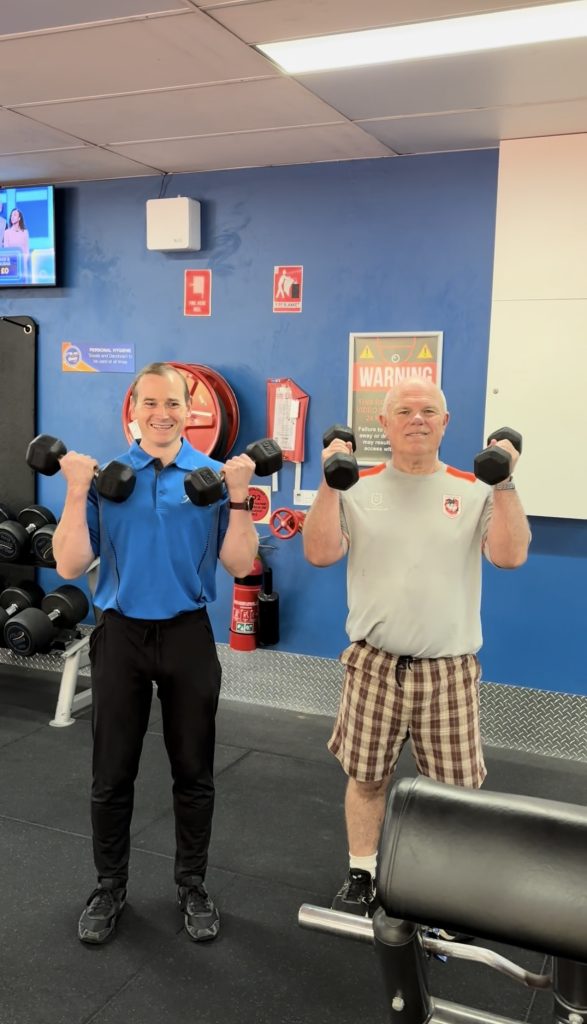Want to Live Longer? How Moving More and Flexible Training Programs Facilitate Longevity.
You want to feel better. Move better. Live longer.
But when you’re dealing with chronic pain, fatigue, or a long-standing condition, it can feel like your body is working against you as opposed to with you.
Maybe workouts have left you sore or sidelined. Maybe rest days turn into rest weeks. And maybe, somewhere deep down, you’ve started wondering if it’s too late to turn your health around.
It is never too late to start or find the exercise approach that works for your condition, goals and schedule.

Longevity Isn’t a Myth: It’s a Movement Habit
Moving more often and exercising regularly can add years to your life and life to your years.
What does science say?
- Just 150 minutes of moderate-intensity movement per week (that’s 30 minutes, 5 days a week) reduces your risk of early death.
- Adding short bouts of light activity throughout your day such as walking improves cardiovascular health and reduces insulin resistance, even in those with chronic disease.
- People who sit for more than 8 hours a day with little activity have a risk of death similar to people who smokes or those dealing with obesity.
The main thing is just to get moving! How you complete the exercise and pencil it into your routine around your work and obligations is up to you. But this can often be hard, especially if you are managing a chronic condition or injury. You might ask questions such as:
- How much pain is too much pain?
- Is this exercise safe to perform?
- I feel great for a few weeks and suddenly things stop working the way they did. Is this normal?
This is where speaking to an Exercise Physiologist can be very helpful. We work with you to develop an individualised plan suitable to your needs and goals.
Movement Is Your Most Powerful Medicine
Here’s the truth: the human body is designed to move and when it doesn’t, everything from mood to metabolism declines.
But you don’t need rigid training routines. You need consistent, daily action.
At Longevity, we help clients:
- Find an exercise routine suitable to their injury or condition.
- Develop daily exercise habits that improve quality of life and longevity.
- Build strength safely (essential for joint stability and healthy aging).
- Improve mobility to reduce stiffness and fall risk.
- Make movement feel enjoyable again.
At Longevity, our philosophy is:
- Gym-based and functional (yes, even for those with injury or illness)
- Delivered in 60-minute one-on-one sessions for safety, customisation and real progress.
- Built around daily movement habits tailored to your current ability and schedule.
- Collaborate with allied health professionals to ensure continuity of care.
- Backed by a lifetime booking system because we understand that real results come from consistency.
Daily Movement: Flexible, Forgiving, and Built for Real Life
One of the biggest reasons people struggle to stick with traditional exercise programs is that they’re rigid. Miss a Monday and suddenly you can feel like you are off track. Traditional training blocks are structured around fixed days and fixed intensities, which is ideal for performance but may lack the flexibility required to manage chronic conditions and injuries and competing responsibilities.
Modifiable and individualised exercise programs can increase consistency and can often be more appropriate for people managing a chronic disease or injury.
From Chronic Pain to Consistent Progress
If you are looking for an exercise program and regime built specifically for you, a Longevity Exercise Physiologist will be able to help. Undertake supervised exercise physiology sessions to help you navigate complex conditions and injuries and build a sustainable exercise practice to increase your strength and function, manage your pain and ultimately improve your quality of life.
Ready to take the first step toward increasing your fitness and lifespan? Call Longevity Exercise Physiology Ascot Vale, Burwood, Casey, Castle Hill, Coburg, Drummoyne, Edgecliff, Five Dock, Gladesville, Gungahlin, Kingsgrove, Liverpool, Macarthur Campbelltown, Macarthur Tindall, Marrickville, Neutral Bay, Penrith, Pymble, Pyrmont, Randwick, Rhodes, Rosebery, Springfield, Yamanto today on 1300 964 002 to book your personalised session or a 15-minute free phone consultation.
Written by Omar Barbar
Reference List
1. Ekelund, U. et al. (2016). Does physical activity attenuate, or even eliminate, the detrimental association of sitting time with mortality? The Lancet, 388(10051), 1302–1310. https://doi.org/10.1016/S0140-6736(16)30370-1.
2. Owen, N., Healy, G. N., Matthews, C. E., & Dunstan, D. W. (2010). Too much sitting: the population health science of sedentary behavior. Exercise and Sport Sciences Reviews, 38(3), 105–113. https://doi.org/10.1097/JES.0b013e3181e373a2.
3. Kyu, H. H., et al. (2016). Physical activity and risk of breast cancer, colon cancer, diabetes, ischemic heart disease, and ischemic stroke events: systematic review and dose-response meta-analysis. BMJ, 354. https://doi.org/10.1136/bmj.i3857.
